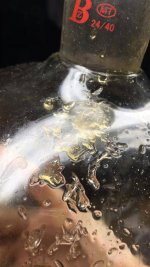Daub Marley
Member
It will. I've done it with pentane and a NaOH solution. I didn't take notes and didn't keep good control of the pH, but the yield seemed pretty small. I don't have any more fresh material though so I cannot repeat. All carboxylic acids regardless how hydrophobic it is will form a water soluble metal salt when mixed with a strong base.I have a jar full of NaOH wash and nonpolar that I need to separate.. I believe it'll work.



